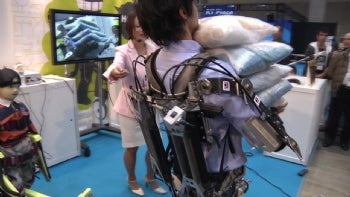
The Pentagon's hope of having a squadron of unmanned aerial vehicles (UAV) capable of staying in the air and performing surveillance for years rather than hours recently took a small step forward. Working with U.K.-based idea factory QinetiQ Group PLC, researchers from the U.S. Defense Advanced Research Project Agency (DARPA) managed to keep the solar-powered Zephyr high-altitude, long-endurance aircraft in the air over the Arizona desert for 82 hours 37 minutes, beating the 54-hour flight completed last year by an earlier version of the aircraft, the company reports on its Web site.
Launched by hand, the 66-pound (30-kilogram) Zephyr is an ultra-lightweight carbon-fiber aircraft that during the day flies on solar power generated by silicon solar arrays no thicker than sheets of paper that cover the aircraft's wings. At night it's powered by SION Power Inc.'s rechargeable lithium-sulfur batteries (recharged during the day using solar power), according to the company.
The flight, took place between July 28 and 31 as researchers guided the Zephyr by remote control to an operating altitude in excess of 60,000 ft (18 km), according toBBC News. After that, the aircraft, which carried a 4.4-pound (2-kilogram) payload, flew on autopilot and via satellite communication.
The Zephyr could be the predecessor of DARPA's proposed Vulture (Very high altitude, Ultraendurance, Loitering Theater Unmanned Reconnaissance Element) project, to create an aircraft that can remain above a surveillance target for at least five years. Under the current plans, the Vulture would weigh 1,000 pounds (453.5 kilograms) and be designed to collect its power from its environment—via solar or some other source—to store and use energy efficiently, and include a robotic refueling capability. With a wingspan of between 300 and 500 feet (between 91.4 and 152.4 meters), the Vulture would function like a low-orbit satellite as much as like an aircraft, staying aloft far longer than any surveillance plane can today.
Launched by hand, the 66-pound (30-kilogram) Zephyr is an ultra-lightweight carbon-fiber aircraft that during the day flies on solar power generated by silicon solar arrays no thicker than sheets of paper that cover the aircraft's wings. At night it's powered by SION Power Inc.'s rechargeable lithium-sulfur batteries (recharged during the day using solar power), according to the company.
The flight, took place between July 28 and 31 as researchers guided the Zephyr by remote control to an operating altitude in excess of 60,000 ft (18 km), according toBBC News. After that, the aircraft, which carried a 4.4-pound (2-kilogram) payload, flew on autopilot and via satellite communication.
The Zephyr could be the predecessor of DARPA's proposed Vulture (Very high altitude, Ultraendurance, Loitering Theater Unmanned Reconnaissance Element) project, to create an aircraft that can remain above a surveillance target for at least five years. Under the current plans, the Vulture would weigh 1,000 pounds (453.5 kilograms) and be designed to collect its power from its environment—via solar or some other source—to store and use energy efficiently, and include a robotic refueling capability. With a wingspan of between 300 and 500 feet (between 91.4 and 152.4 meters), the Vulture would function like a low-orbit satellite as much as like an aircraft, staying aloft far longer than any surveillance plane can today.
Government contractors Aurora Flight Sciences, Boeing and Lockheed Martin are working on the first phase of the Vulture project, which began in April. The contractors are studying possible designs and configurations during this year-long first phase, which will conclude with a review of smaller and full-size demo aircraft, says DARPA spokeswoman Jan Walker. The next phase is expected to include an uninterrupted, three-month flight test of a smaller version of the Vulture. In the third and final phase, the program will conduct a flight test of a full-scale Vulture during which the vehicle will be in the air for an entire year without landing.
"The Zephyr flight demonstrates the continuous improvement of all of the systems--solar cells, battery, light weight structural components, aerodynamic design, power management, and energy harvesting--to make (long-term, unmanned flight) possible," Jamey Jacob, an Oklahoma State University associate professor of mechanical and aerospace engineering, told ScientificAmerican.com. "I anticipate that records will begin to fall rather quickly as more platforms make use of the evolving technology."
One record that's already fallen is the current official world record for unmanned flight set by the U.S. robot plane Global Hawk—of 30 hours, 24 minutes. (QinetiQ's flight is an unofficial record because it did not involve the FAI (Federation Aeronautique Internationale), the world air sports federation, which sanctions all record attempts.
Another budding UAV project is Oklahoma State University's Pterosoar-B, which on July 1 set two new aviation world records for flight in the FAI category for autonomous aircraft of less than 5 kg with a duration of 6 hours, 15 minutes, and 54 seconds, and distance in a closed course of 122 km.
"The Zephyr flight demonstrates the continuous improvement of all of the systems--solar cells, battery, light weight structural components, aerodynamic design, power management, and energy harvesting--to make (long-term, unmanned flight) possible," Jamey Jacob, an Oklahoma State University associate professor of mechanical and aerospace engineering, told ScientificAmerican.com. "I anticipate that records will begin to fall rather quickly as more platforms make use of the evolving technology."
One record that's already fallen is the current official world record for unmanned flight set by the U.S. robot plane Global Hawk—of 30 hours, 24 minutes. (QinetiQ's flight is an unofficial record because it did not involve the FAI (Federation Aeronautique Internationale), the world air sports federation, which sanctions all record attempts.
Another budding UAV project is Oklahoma State University's Pterosoar-B, which on July 1 set two new aviation world records for flight in the FAI category for autonomous aircraft of less than 5 kg with a duration of 6 hours, 15 minutes, and 54 seconds, and distance in a closed course of 122 km.




















